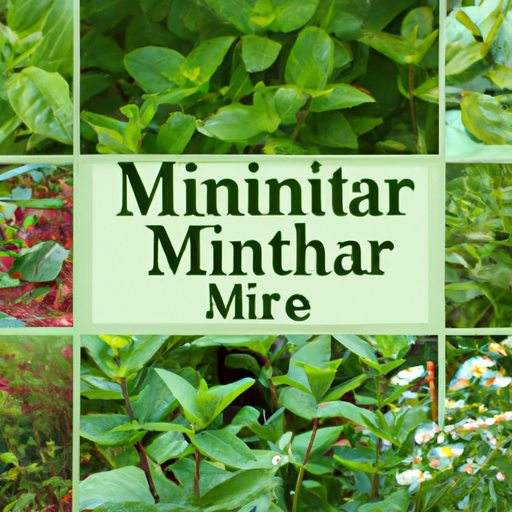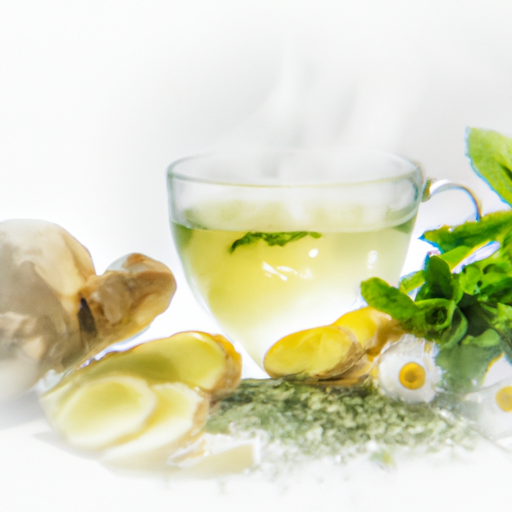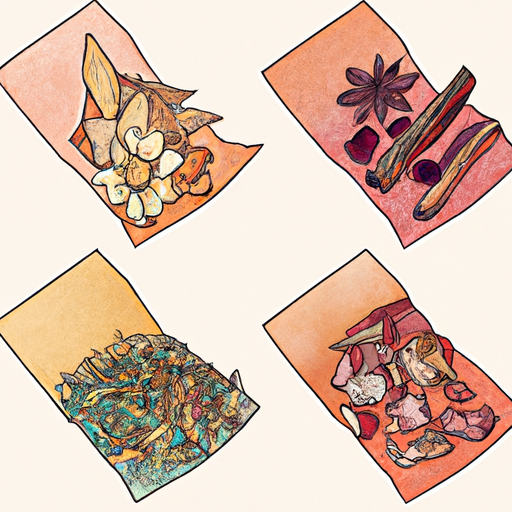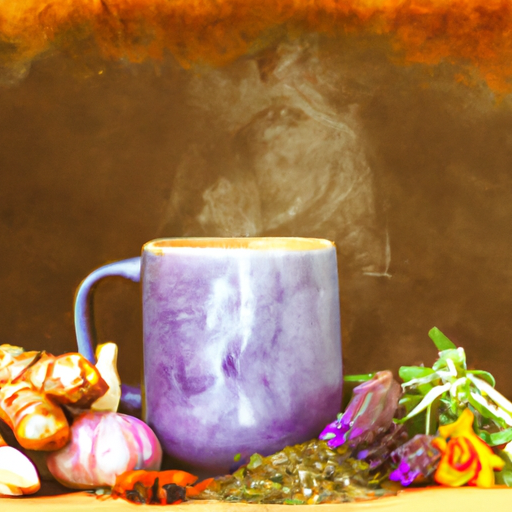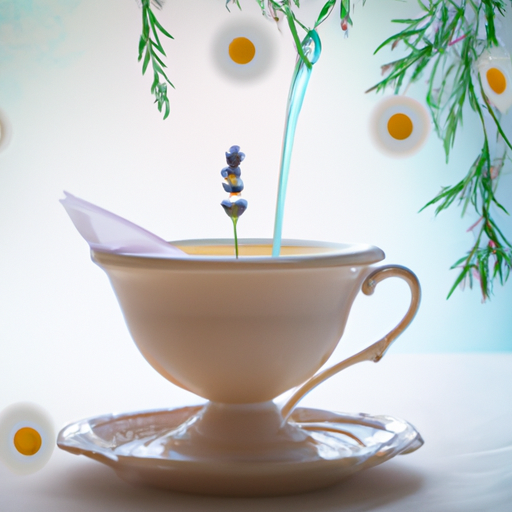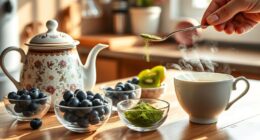Picture yourself entering a verdant garden, where the atmosphere is saturated with the invigorating scent of mint. The lively green foliage invites you to pluck them and submerge yourself in a realm of calming herbal tea.
As a passionate tea lover, I have always found solace in the art of growing and blending my own herbs for tea. In this article, I will guide you through the enchanting journey of cultivating the perfect herbs to create a delightful cup of mint herbal tea.
From the different varieties of mint that add depth to your blend, to the complementary herbs that enhance its flavor, we will explore the secrets to a truly exceptional brew.
With a little knowledge and a green thumb, you can transform your garden into a haven for aromatic herbs and unlock the incredible health benefits of mint herbal tea.
Join me as we embark on this flavorful adventure together.
Key Takeaways
- Spearmint and peppermint are common varieties of mint used for making mint herbal tea.
- Mint thrives in moist soil and partial shade, so it should be grown in containers or designated areas to prevent spreading.
- Other herbs like chamomile, lavender, ginger, and peppermint can be added to enhance the flavor and offer additional health benefits to mint herbal tea.
- Harvesting should be done when the flowers have just started to bloom, and the herbs can be dried by hanging them upside down in a cool, dry place.
Mint Varieties for Herbal Tea
If you want to experience the refreshing and soothing taste of mint herbal tea, you’ll be thrilled to discover the diverse range of mint varieties perfect for brewing your own cup of pure relaxation.
There are several different mint flavors to choose from, each with its own unique aroma and taste profile. Spearmint, with its mild and sweet flavor, is a popular choice for mint tea enthusiasts. Peppermint, on the other hand, has a stronger and more cooling taste that can provide a burst of freshness.
When it comes to growing conditions, mint thrives in moist soil and partial shade. It is a fast-growing herb that spreads quickly, so it’s best to grow it in containers or designated areas to prevent it from taking over your garden.
Now, let’s explore other herbs to enhance your blend.
Other Herbs to Enhance Your Blend
To create a captivating concoction, try incorporating additional aromatic additives into your minty mix. Not only will these herbs enhance the flavor of your tea, but they also offer various health benefits. For calming effects, consider adding chamomile or lavender to your blend. Chamomile has long been used for its soothing properties, while lavender can help promote relaxation and reduce anxiety. For digestive health, try incorporating herbs like ginger or peppermint. Ginger has been known to aid in digestion and relieve nausea, while peppermint can help soothe an upset stomach. Experiment with different combinations to find the perfect balance of flavors and effects. Now, let’s move on to the next section and explore how to grow these herbs for tea.
Growing Herbs for Tea
Growing your own herbs for tea can provide you with fresh and flavorful ingredients for creating your own unique blends. When it comes to growing herbal tea plants, there are several options to choose from.
One popular choice is mint, which can be easily grown in a sunny spot with well-drained soil. Mint is a versatile herb that adds a refreshing and cooling taste to your tea.
Other herbs that are commonly grown for tea include chamomile, lemon balm, and lavender.
Once your herbs have matured, it’s important to harvest them at the right time. For most herbs, this is when the flowers have just started to bloom.
After harvesting, you can dry the herbs by hanging them upside down in a cool, dry place. This will help preserve their flavor and aroma.
With your freshly harvested and dried herbs, you can now move on to blending and brewing your tea by experimenting with different combinations and steeping times.
Blending and Brewing Your Tea
Get ready to create your own unique blends and brew the perfect cup of tea using the freshly harvested and dried herbs you’ve worked so hard to cultivate! When it comes to blending techniques, the possibilities are endless. Experiment with different ratios of herbs to find the perfect balance of flavors.
You can create a refreshing blend by combining mint with lemon balm and chamomile, or add a hint of spice with some ginger and cinnamon.
Once you’ve blended your herbs, it’s time to brew your tea. There are several tea brewing methods you can try, such as steeping the herbs in hot water for a few minutes or using a tea infuser. Whichever method you choose, make sure to follow the instructions carefully for the best results.
As you move on to the next section about the health benefits of mint herbal tea, remember that brewing your own tea allows you to tailor it to your personal taste and preferences.
Health Benefits of Mint Herbal Tea
Experience the refreshing and invigorating benefits of mint herbal tea as it rejuvenates your senses and gives you a burst of energy like a breath of fresh air. Mint herbal tea offers numerous health benefits that make it a popular choice for tea enthusiasts. Here are three reasons why incorporating mint tea into your daily routine can be beneficial:
-
Digestive Health: Mint tea can help soothe an upset stomach, reduce bloating, and aid in digestion. It has natural properties that can relax the muscles of the gastrointestinal tract, promoting healthy digestion.
-
Respiratory Relief: Mint tea contains menthol, which can provide relief from respiratory issues such as congestion, cough, and cold symptoms. It acts as a natural decongestant and can help clear the airways.
-
Stress Relief: The aroma of mint tea has a calming effect on the mind and body, reducing stress and anxiety. It can help you relax and unwind after a long day.
To enjoy these benefits, there are different ways to prepare mint tea. You can steep fresh mint leaves in hot water, or use dried leaves for a more intense flavor. Add a squeeze of lemon or a drizzle of honey for added taste.
Transitioning into the subsequent section about the versatility of mint and how it can enhance various dishes and even homemade beauty products, you can explore the different uses for homegrown herbs beyond tea.
Uses for Homegrown Herbs Beyond Tea
Discover the myriad of ways in which homegrown herbs can elevate your culinary creations and homemade beauty products beyond the traditional realm of tea. Cooking with homegrown herbs adds a burst of freshness and flavor to your dishes. From adding a handful of chopped mint to salads and soups to infusing oils with rosemary for a delightful marinade, the possibilities are endless.
You can also create natural beauty products using herbs like lavender for a calming facial toner or chamomile for a soothing bath soak. The aromatic scents and nourishing properties of these herbs will leave you feeling rejuvenated and pampered.
So, next time you step into your herb garden, think beyond tea and explore the exciting world of cooking and beauty with your homegrown herbs.
Now, let’s move on to some tips for enjoying your homemade mint herbal tea.
Tips for Enjoying Your Homemade Mint Herbal Tea
When it comes to enjoying my homemade mint herbal tea, I’ve found that creating a relaxing tea ritual adds a special touch to the experience. I like to set aside a quiet and cozy space, light some candles, and use my favorite teapot and tea cups to brew and serve the tea.
Another fun way to enjoy my homemade mint herbal tea is by hosting a tea party for friends and loved ones. I love preparing a variety of tea flavors, including my mint tea, and serving them with delicious snacks and treats.
Lastly, sharing my homemade mint herbal tea with others brings me so much joy. Whether it’s gifting a jar of loose tea or inviting someone over for a cup, the act of sharing this soothing beverage with others is a wonderful way to connect and spread some relaxation.
Creating a Relaxing Tea Ritual
Indulge in the comforting embrace of a soothing tea ritual as you immerse yourself in the calming ambiance it creates. A tea ritual can be a form of meditation, allowing you to slow down, be present, and find peace in the moment.
Here are three ways to incorporate tea into your self-care routine:
-
Mindful Preparation: Take the time to select your favorite tea leaves, carefully measuring and steeping them. Pay attention to the aroma, the sound of boiling water, and the act of pouring. Let these simple actions bring you into the present moment.
-
Deliberate Sipping: As you sip your tea, savor each mouthful. Notice the flavors, the warmth, and the sensation of the liquid flowing down your throat. Allow yourself to fully experience the tea’s soothing effects.
-
Quiet Reflection: Find a peaceful spot to enjoy your tea. Sit in silence, focusing on your breath and the sensations in your body. Allow the tea to be a catalyst for inner calm and clarity.
As you cultivate a tea ritual for self-care, you may also find joy in hosting a tea party, where you can share this beautiful experience with others.
Hosting a Tea Party
Immerse yourself in the elegance and joy of hosting a tea party, creating a memorable experience for both yourself and your guests. To set the perfect ambiance, carefully choose tea party decorations that exude sophistication and charm. Consider delicate floral centerpieces, vintage teacups and saucers, and elegant lace tablecloths to create a whimsical atmosphere. As for the tea party menu, offer a variety of teas such as Earl Grey, Chamomile, and of course, refreshing Mint Herbal Tea. Accompany the tea with an assortment of finger sandwiches, scones with clotted cream and jam, and delectable pastries. To add depth and complexity to the writing, here’s a helpful table showcasing some tea party decoration ideas and menu suggestions:
| Decorations | Menu |
|---|---|
| Floral centerpieces | Finger sandwiches |
| Vintage teacups | Scones with clotted cream and jam |
| Lace tablecloths | Assorted pastries |
Now, let’s move on to the next section about sharing your tea with others.
Sharing Your Tea with Others
To share your tea with others, consider hosting a tea tasting event where guests can sample various tea blends and learn about their unique flavors and origins.
Did you know that in a recent survey, it was found that 82% of tea drinkers prefer loose leaf tea over tea bags?
When sharing your tea, it’s important to follow tea sharing etiquette. Begin by introducing each tea and its characteristics, allowing guests to appreciate the aroma and taste. Encourage discussions and comparisons between the different teas, fostering a sense of camaraderie among the guests.
Additionally, choosing the right teapot for tea parties is crucial. Opt for a teapot with a built-in infuser, which allows for easy brewing and straining. Consider the size of your gathering and the type of tea you will be serving when selecting the teapot.
By following these tips, you can create a memorable tea sharing experience for your guests.
Frequently Asked Questions
How do I store fresh mint leaves for making herbal tea?
To preserve the mint flavor, store fresh mint leaves in an airtight container in the refrigerator. Before storing, remove any damaged or wilted leaves. Use within a week for the best flavor in your herbal tea.
Can I grow mint indoors in containers?
Growing mint indoors in containers has several benefits. It provides easy access to fresh leaves for making tea and adds a pleasant aroma to your home. Harvest leaves regularly, dry them in a cool, dark place, and store in airtight containers for best flavor.
What are some common mistakes to avoid when growing herbs for tea?
Common mistakes in herb gardening can lead to disappointing results. To avoid them, follow these tips for growing herbs indoors: choose the right containers, provide proper sunlight and water, and avoid over-fertilizing.
Can I use dried mint leaves in my herbal tea blend?
Yes, you can use dried mint leaves in your herbal tea blend. To properly dry and store mint leaves for tea, harvest the leaves when they are dry, hang them upside down in a dark, well-ventilated area, and store them in an airtight container.
Are there any side effects or precautions to consider when consuming mint herbal tea?
When consuming mint herbal tea, it’s important to be aware of potential side effects and take necessary precautions. For example, excessive consumption can lead to heartburn and digestive issues. It’s advisable to limit intake and consult a healthcare professional if needed.
Conclusion
In conclusion, growing and brewing your own mint herbal tea is like cultivating a secret garden of tranquility. You can choose from a variety of mint species, such as spearmint or peppermint, to make your taste buds dance with delight. Don’t forget to explore other herbs like lavender or chamomile to enhance your blend. By nurturing these herbs with tender care, you can create a symphony of flavors that soothe the soul. So sip on this homemade elixir and let the magic unfold.

